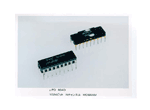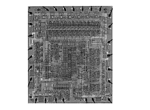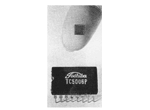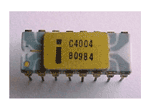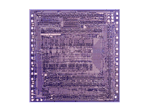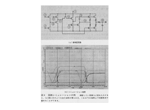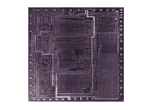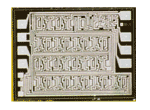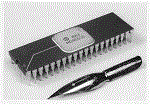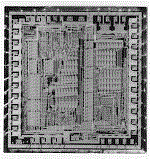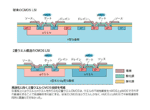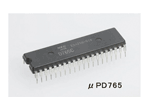Integrated Circuits
1970s
Decade of LSIsBoth memory devices, such as DRAMs and SRAMs, and microprocessors made rapid progress in this decade. The U.S. took the lead in developing these LSI circuits for industrial applications, and Japan followed to catch up.Single-chip LSI circuits for use in consumer products such as calculators and watches also evolved. CMOS technology developed for the LSI circuits of calculators and watches also spread into the SRAM field.
1970s: Manufacturers in Japan enter the DRAM market and integration densities are improved
Manufacturers in Japan followed Intel into the DRAM market. In 1971, NEC developed a 1-Kbit DRAM, adopting an NMOS design for its high speed capability. The degree of integration of DRAM rapidly improved from 1 Kbit to 4 Kbits and then 16 Kbits. In 1976, the VLSI Technology Research Association was established and actively promoted various developments, including basic technology. These activities greatly contributed to the development of DRAM by Japanese manufacturers.
1970s: Development and evolution of microprocessors
In the 1970s, following Intel’s lead, Japanese semiconductor manufacturers such as NEC Corporation, Toshiba Corporation, and Hitachi, Ltd. developed and mass-produced microprocessors, starting with 4-bit devices and then advancing to 8- and 16-bit devices. Microprocessors were initially for industrial use, but the fields of application soon expanded to include office equipment, home appliances, computer terminals, automobiles, and industrial equipment.
1970s: SRAM evolution
In 1969, Intel released a 256-bit PMOS SRAM, the 1101. Intel then released a 1-Kbit NMOS SRAM and a 1-Kbit CMOS SRAM. At this time, Japanese manufacturers lagged behind Intel even in SRAM development and sales. In the beginning, SRAM was developed along two lines: fast NMOS-based SRAM and low-power (slow) CMOS-based SRAM. Later, however, CMOS also came to be used for fast SRAM.
1970s: CAD tools appear
In addition to circuit simulation done on mainframe computers, the use of other computer-aided design (CAD) tools gradually began to spread. The first widely used tools were CAD tools to digitize semiconductor layout data, provided by companies like Calma and Applocon and the tools for circuit schematic entry.
1970: 1-Kbit DRAM (Intel, U.S.A.)
In 1970, Intel released the world’s first 1-Kbit DRAM, the 1103. The 1103 was a PMOS DRAM with three-transistor memory cells. DRAM rapidly replaced the core memory that had previously been the major form of computer memory.
1971: 2-Kbit EPROM (Intel, U.S.A.)
In 1971, Intel developed a 2-Kbit erasable/programmable read-only memory (EPROM) as a form of nonvolatile memory. This product was revolutionary because of its electrical programmability and erasability. Since ultraviolet light is used for erasure, this memory is also called ultraviolet EPROM (UV-EPROM).
1971: 4-bit microprocessor (Intel, U.S.A.)
In 1971, Intel released the world’s first microprocessor, the 4004. This was a 4-bit microprocessor incorporating 2,300 transistors and operating at a clock frequency of 108 kHz. This product originated in a request from Busicom, a calculator manufacturer in Japan, for Intel to develop calculator chips.
1972 to 1973: CMOS LSI circuits for calculators (Sharp and Toshiba)
In 1972, an LED calculator, the Elsi Mini, was released. This was the world’s first calculator to incorporate a CMOS LSI circuit. In 1973, the world’s first liquid-crystal display calculator, the Elsi Mate EL-805, was released. This was jointly developed by Sharp and Toshiba, with Toshiba producing the CMOS LSI circuits and Sharp producing the calculators. These were pioneering products in the era of CMOS LSI circuits for consumer applications.
1973: SPICE developed (University of California, Berkeley, U.S.A.)
In the beginning of the 1970s, circuits were designed with the aid of calculators or manual calculations since IC circuits were small-scale and computers were not sufficiently advanced for this task. The use of computers in design began to increase, however, and UC Berkeley developed the SPICE (simulation program with integrated circuit emphasis) circuit simulator in 1973. This made circuit simulation on mainframe computers practicable.
1973: 12-bit engine-control microprocessor (Toshiba)
Toshiba joined the Electronic Engine Control (EEC) project of the Ford Motor Company in 1971 and developed the world’s first 12-bit microprocessor in 1973. This was the first microprocessor in which the microprogram control method was adopted. The CPU chip had about 2800 integrated gates and its size was 5.5 mm x 5.9 mm.
1974: Report on MOSFET scaling principles (R. Dennard, IBM, U.S.A.)
With regard to the miniaturization of MOSFET fabrication processes, Dennard presented a prediction of device performance when related parameters (density of impurities, power-supply voltage, etc.) together with the physical dimension of devices were changed in certain scaling ratios. This scaling principle became a basic guideline for miniaturization of MOSFET.
Early 1970s: Evolution of CMOS LSI circuits for watches
In December, 1969, the Seiko Watch Corporation began selling the world’s first quartz watch, the Astron. The market for quartz watches expanded quickly, leading to rapid growth in the demand for CMOS LSI circuits to be used in watches.
Power consumption is a key factor for watches, so LSI circuits for watches required CMOS as a low-power consumption technology.
The demand for LSI circuits to be used in watches and calculators over this period drove the Japan's semiconductor industry forward.
Late 1970s: Commercialization of Microcomputer peripheral LSIs such as CRTC (Hitachi)
In the late 1970s, microcomputer CPUs were evolving from 4-bit to 8-bit, and many peripheral LSIs became available. Among them, Hitachi's CRT controller (CRTC) was developed and has been used for a long time thereafter in many microcomputer application systems as a standard component for CRT display devices.
1978: Double-well fast CMOS SRAM (Hitachi)
Hitachi released a 4-Kbit fast SRAM at the International Solid-State Circuits Conference (ISSCC) in 1978. This SRAM used a double-well CMOS structure and achieved a speed equivalent to that of NMOS memory. This demonstrated that CMOS could also be used where high speed was needed and encouraged the subsequent expansion of CMOS applications to encompass DRAM and microprocessors.
1979: Single-chip floppy disk controller (NEC)
In 1979, NEC developed a controller that supported the world-standard floppy disk format. This controller was incorporated within a personal computer (PC) released by IBM and then was adopted in many information devices as well as PCs, becoming the de facto standard for floppy disk controllers.


